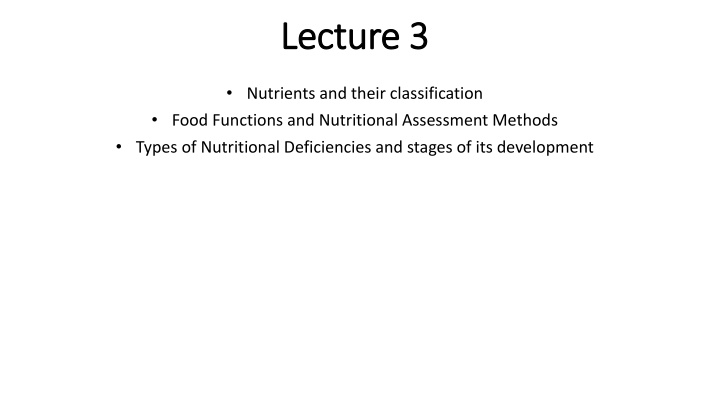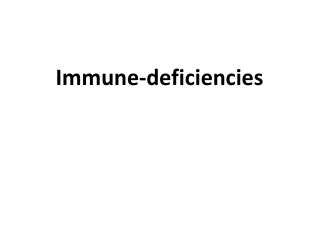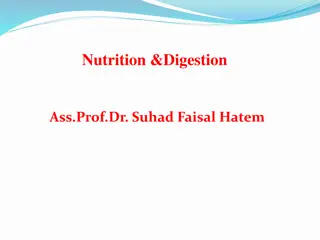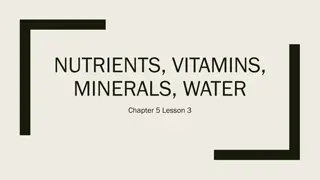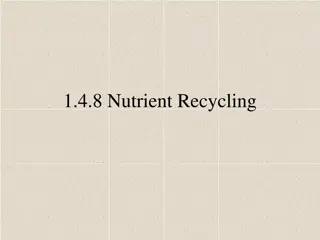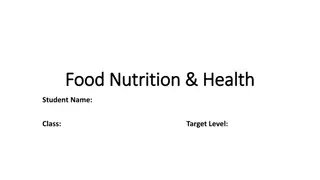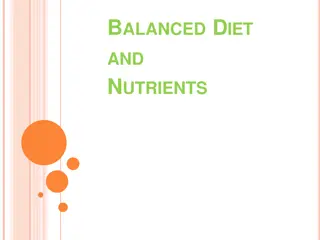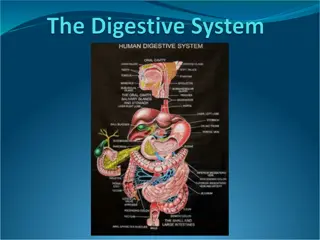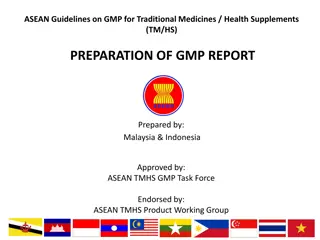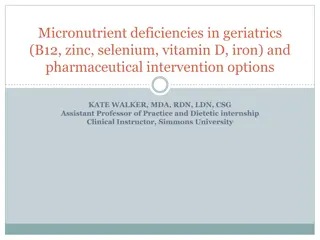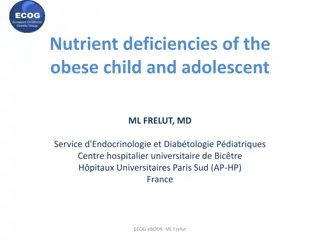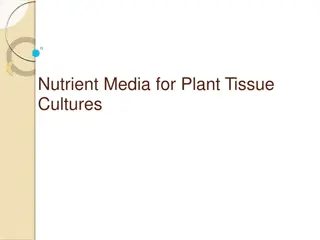Nutrients Classification, Functions, and Deficiencies
Food, nutrients, and their classification into macronutrients and micronutrients are crucial for promoting health and preventing deficiencies. Learn about the functions of macronutrients and micronutrients, as well as the importance of maintaining optimal nutritional status. Explore methods for assessing nutritional status through anthropometric, biochemical, clinical, and dietary measurements.
Download Presentation

Please find below an Image/Link to download the presentation.
The content on the website is provided AS IS for your information and personal use only. It may not be sold, licensed, or shared on other websites without obtaining consent from the author.If you encounter any issues during the download, it is possible that the publisher has removed the file from their server.
You are allowed to download the files provided on this website for personal or commercial use, subject to the condition that they are used lawfully. All files are the property of their respective owners.
The content on the website is provided AS IS for your information and personal use only. It may not be sold, licensed, or shared on other websites without obtaining consent from the author.
E N D
Presentation Transcript
Lecture 3 Lecture 3 Nutrients and their classification Food Functions and Nutritional Assessment Methods Types of Nutritional Deficiencies and stages of its development
Food is anything that you can eat. It's a very general term. Diet: When foods made into deferent forms/formulations.. A meal is when you sit down at a table and eat things. If you sit down to eat a meal in the morning, it's breakfast. If you sit down to eat a meal at night, it's dinner. Nutrient: Components of food/diet that are known on the basis of their unique chemical composition Nourishment: indicates benefit we get from food Nutrition: Theoretical understanding of foods/diet for health. Dietetics: Practical Application of Nutrition Food Diet Meal Nutrient Nourishment Nutrition Dietetics
Nutrients and their classification Carbohydrates Proteins Fats Vitamins Minerals Water Energy .? Macronutrients: needed in large amounts by the body i.e. protein, fat and carbohydrate. Micronutrients: Needed in small amounts by the body i.e. vitamins, minerals WATER Macro-or Micro?
Macronutrients Macronutrients FUNTIONS provide energy to the body provide structure to tissues regulate hormonal processes within the body protect the internal organs
Micronutrients Micronutrients FUNCTIONS Regulation of the functions of Macronutirients a. Energy b. Growth/development c. Hormones regulations d. Immunity & Defense e. Magnesium helps prevent heart disease by regulating the rhythm of heartbeats and muscular activity in the heart. f. Zinc, selenium and phosphorus play an important role in the regulation and activation of other micronutrients. g. B-complex vitamins are better absorbed and assimilated by the body when combined with adequate levels of zinc.
Nutritional Status Nutritional Status Functions of Macro- and Micronutrients promote health If nutrients are doing their functions Nutritional status. Nutritional Status: The condition of the body in those respects influenced by the diet; the levels of nutrients in the body and the ability of those levels to maintain normal metabolic integrity . is reflected by healthy/positive Growth Development Fight Against Diseases Recovery Scholastic capabilities Cognition
Measurement of Nutritional Status or Nutritional Status Assessment Nutritional Status Assessment: Measurement in quantitative terms whether the functions of nutrients are reflected by the body Methods Anthropometric Biochemical Clinical Dietary ABCD ?
Provide structure to tissues Growth/Development/Maintainace/Recovery Monitoring whether body is having a normal growth or not Measuring Weight, height, Fat tissues, Musceles, bones elongation etc Measurement of growth is called Anthropometry Weight & Height Triceps/Bicep measurement Skull Circumference MUAC (Mid-upper Arm Circumferance)
Anthropometry Anthropometry
What information we get from Nutritional status What information we get from Nutritional status Assessment Assessment For example: from weight and height, we may know whther the person is growing well or not Problem in physical growth: a. Stunting b. Underweight c. Wasted
Stunting: Stunted growth, also known as stunting and nutritional stunting, is a reduced growth rate in human development. It is a primary manifestation of malnutrition (or more precisely undernutrition) infections, such as diarrhea and helminthiasis, in early childhood and even before birth, due to malnutrition development brought on by a malnourished mother. The definition of stunting according to the WHO is for the "height for age" value to be less than two standard deviations of the WHO Child Growth Standards median. Chronic Malnutrition and recurrent during fetal
Wasted: Wasted refers to low weight-for-height where a child is thin for his/her height but not necessarily short. Also known as acute malnutrition, this carries an immediate increased risk of morbidity and mortality. Wasted children have a 5-20 times higher risk of dying from common diseases like diarrhoea or pneumonia than normally nourished children.
Under-weight: Under- weight refers to low weight-for-age, when a child can be either thin or short for his/her age. WHO: weight for age to be less than two standard deviations of the WHO Child Growth Standards median. This reflects a combination of chronic and acute malnutrition.
Summary for today Summary for today If children are not getting enough food in their first 5 years of life, they may become: Stunted, Underweight,or wasted All the three conditions can occur simultaneously Causes: Primary Malnutrition Secondary Malnutrition Acute Malnutrition Chronic Malnutrition Other Nutrition related negative conditions
